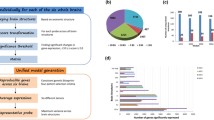Abstract
Apoptosis is a key physiological response that occurs during development of the nervous system, resulting in the death of nearly half of the embryonic neuronal population. Aberrant apoptotic mechanisms are thought to contribute significantly to many neurological disorders including Alzheimer’s disease. Although many experiments in the past have demonstrated the requirement of de novo gene expression during neuronal apoptosis, the complete spectrum of genes involved in distinct temporal domains is mostly unknown. To begin a comprehensive survey of the gene-based molecular mechanisms that underlie neuronal apoptosis, we have used the unprecedented experimental opportunities that genome sequences and the development of DNA microarray technology now provide to perform genome-wide expression analysis in different paradigms of neuronal apoptosis. In order to extract knowledge from gene expression information we have developed new informatics applications that enable clustering methods based on semantic characteristics, such as gene ontologies. This review will highlight the use of a genomic approach to identify the molecular program underlying neuronal apoptosis and illustrate how a semantic clustering method can be useful to extract more knowledge from microarray data.






Similar content being viewed by others
References
Arends, M. J., & Wyllie, A. H. (1991). Apoptosis: Mechanisms and roles in pathology. International Review of Experimental Pathology, 32, 223–254.
Atlante, A., Bobba, A., Calissano, P., Passarella, S., & Marra, E. (2003). The apoptosis/necrosis transition in cerebellar granule cells depends on the mutual relationship of the antioxidant and the proteolytic systems which regulate ROS production and cytochrome c release en route to death. Journal of Neurochemistry, 84, 960–971.
Atlante, A., Gagliardi, S., Minervini, G. M., Marra, E., Passarella, S., & Calissano, P. (1996). Rapid uncoupling of oxidative phosphorylation accompanies glutamate toxicity in rat cerebellar granule cells. NeuroReport, 7, 2519–2523.
Borsello, T., Di Luzio, A., Ciotti, M. T., Calissano, P., & Galli, C. (2000). Granule neuron DNA damage following deafferentation in adult rats cerebellar cortex: A lesion model. Neuroscience, 95, 163–171.
Cavallaro, S., D’Agata, V., Alessi, E., Coffa, S., Alkon, D. L., Manickam, P., et al. (2004). Gene expression profiles of apoptotic neurons. Genomics, 84, 485–496.
D’Mello, S. R., & Chin, P. C. (2005). Treating neurodegenerative conditions through the understanding of neuronal apoptosis. Current Drug Targets. CNS. Neurology Disorders, 4, 3–23.
D’Mello, S. R., Galli, C., Ciotti, T., & Calissano, P. (1993). Induction of apoptosis in cerebellar granule neurons by low potassium: Inhibition of death by insulin-like growth factor I and cAMP. Proceedings of the National Academy of Sciences of the United States of America, 90, 10989–10993.
Eisen, M. B., Spellman, P. T., Brown, P. O., & Botstein, D. (1998). Cluster analysis and display of genome-wide expression patterns. Proceedings of the National Academy of Sciences of the United States of America, 95, 14863–14868.
Elvidge, G. (2006). Microarray expression technology: From start to finish. Pharmacogenomics, 7, 123–134.
Forgy, E. W. (1965). Cluster analysis of multivariate data: Efficiency vs interpretability of classifications. Biometrics, 21, 768–769.
Galli, C., Meucci, O., Scorziello, A., Werge, T. M., Calissano, P., & Schettini, G. (1995). Apoptosis in cerebellar granule cells is blocked by high KCl, forskolin, and IGF-1 through distinct mechanisms of action: The involvement of intracellular calcium and RNA synthesis. Journal of Neuroscience, 15, 1172–1179.
Heller, M. J. (2002). DNA microarray technology: Devices, systems, and applications. Annual Review of Biomedical Engineering, 4, 129–153.
Hess, K. R., Zhang, W., Baggerly, K. A., Stivers, D. N., & Coombes, K. R. (2001). Microarrays: Handling the deluge of data and extracting reliable information. Trends in Biotechnology, 19, 463–468.
Huang, Z. (1998). Extensions to the k-means algorithm for clustering large data sets with categorical values. Data Mining and Knowledge Discovery, 2, 283–304.
Jellinger, K. A. (2006). Challenges in neuronal apoptosis. Current Alzheimer Research, 3, 377–391.
Mattson, M. P. (2006). Neuronal life-and-death signaling, apoptosis, and neurodegenerative disorders. Antioxidants & Redox Signalling, 8, 1997–2006.
Noordewier, M. O., & Warren, P. V. (2001). Gene expression microarrays and the integration of biological knowledge. Trends in Biotechnology, 19, 412–415.
Paratore, S., Parenti, R., Torrisi, A., Copani, A., Cicirata, F., & Cavallaro, S. (2006). Genomic profiling of cortical neurons following exposure to beta-amyloid. Genomics, 88(4), 468–479.
Pettmann, B., & Henderson, C. E. (1998). Neuronal cell death. Neuron, 20, 633–647.
Sobek, J., Bartscherer, K., Jacob, A., Hoheisel, J. D., & Angenendt, P. (2006). Microarray technology as a universal tool for high-throughput analysis of biological systems. Combinatorial Chemistry & High Throughput Screening, 9, 365–380.
Sokal, R. R., & Michener, C. D. (1958). A statical method for evaluating systematic relationships. University of Kansas Science Bulletin, 38, 1409–1438.
Tompa, M., Li, N., Bailey, T. L., Church, G. M., De Moor, B., Eskin, E., et al. (2005). Assessing computational tools for the discovery of transcription factor binding sites. Nature Biotechnology, 23, 137–144.
Tryon, R. C. (1939). Cluster analysis. New York: McGraw-Hill.
Williams, R. W., & Herrup, K. (1988). The control of neuron number. Annual Review of Neuroscience, 11, 423–453.
Xiao, Q., & Nikodem, V. M. (1998). Apoptosis in the developing cerebellum of the thyroid hormone deficient rat. Front Bioscience, 3, A52–A57.
Acknowledgments
I gratefully acknowledge Alfia Corsino, Maria Patrizia D’Angelo and Francesco Marino for their administrative and technical support. This work was partly sponsored by grants of the Italian Ministry of Education University and Research (DA 2266; DM 1105/255) to SC.
Author information
Authors and Affiliations
Corresponding author
Rights and permissions
About this article
Cite this article
Cavallaro, S. Neuronal Apoptosis Revealed by Genomic Analysis: Integrating Gene Expression Profiles with Functional Information. Neuroinform 5, 115–126 (2007). https://doi.org/10.1007/s12021-007-0006-3
Published:
Issue Date:
DOI: https://doi.org/10.1007/s12021-007-0006-3




